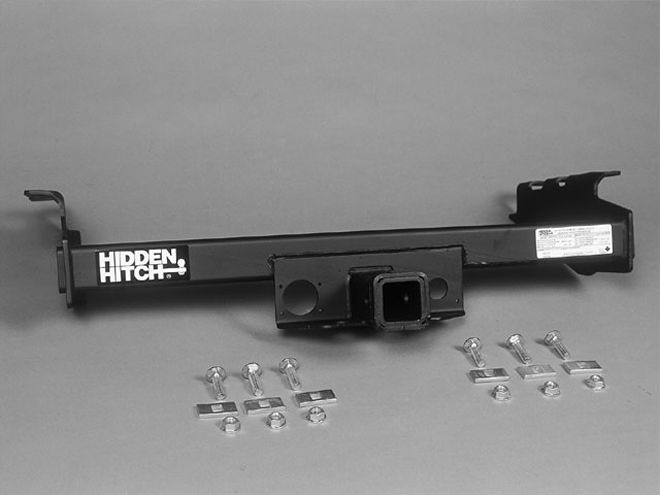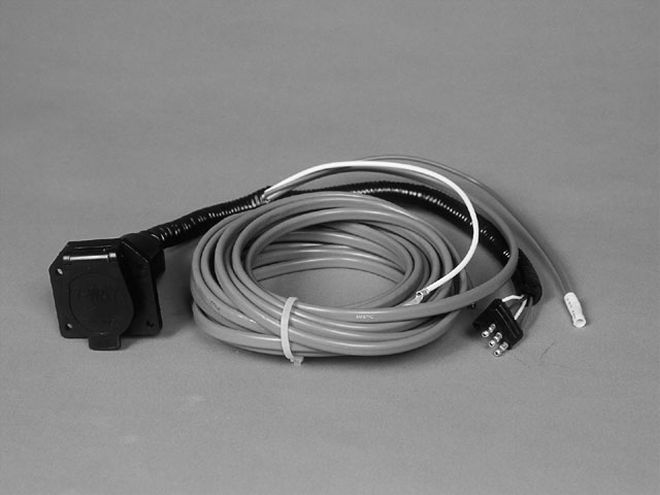
 Hidden Hitch had all we needed. Shown are the Class III/IV 2-inch receiver hitch and the optional seven-way round connector. The kit also includes the T-connector harness and trunion-style weight distribution kit. We opted for the electronic brake controller and low-pressure drop transmission cooler.
Hidden Hitch had all we needed. Shown are the Class III/IV 2-inch receiver hitch and the optional seven-way round connector. The kit also includes the T-connector harness and trunion-style weight distribution kit. We opted for the electronic brake controller and low-pressure drop transmission cooler.
Hindsight can be a downright aggravating thing. We've all had that feeling of, "I wish I would have (fill in the blank) when I had the chance," and one of the more common is, "I wish I would have ordered my truck with a trailer towing package." After placing the order for my 1500 Ram 4x4, I had the same lament, figuring a driveway upgrade would be less expensive if I did it myself.
It's not a difficult problem to fix, but it requires some honest assessment before taking the plunge. Before purchasing any piece of towing equipment, identify what you're planning to tow and its weight, and make sure your truck is up to the job. Not all trucks are created equal as far as towing capabilities are concerned; a 1500-series model doesn't have the towing capacity of a three-quarter or one-ton truck.
A 318 1500 Ram with a manual tranny doesn't have the guts of a 360 automatic when it comes to lugging a heavy load. A truck's towing capabilities depend upon a number of variables in its suspension make-up, engine size, transmission, and gearing. Ascertain the Gross Vehicle Weight Rating, or GVWR, the trailer tongue weight, the vehicle's towing capacity, and the overall number, which is the Gross Capacity Weight Rating, or GCWR. Once you have all of this information, you can select a towing package that will match your truck and its towing requirements.
Hitches are rated by the weight of the item to be towed, and come in the following classifications:
Class I: maximum trailer weight, 2,500 pounds/tongue weight, 250 pounds.
Class II: gross trailer weight 3,500 pounds/tongue weight 300 pounds.
Class III/IV: gross trailer weight 5,000 pounds/tongue weight 500 pounds (class III), or gross trailer weight 10,000 pounds/tongue weight 1,000 pounds (class IV) with weight distribution system.
Class V: gross trailer weight 10,000 pounds/tongue weight 1,200 pounds, or gross trailer weight 14,000 pounds with weight distribution system.
Fifth-Wheel/Gooseneck: gross trailer weight up to 30,000 pounds.

Generally speaking, for folks who plan to tow recreational campers, boats, or cars (flatbed or box trailers), the Class III/IV hitches usually serve the purpose. In most cases, Class III and IV hitches are identical (same part number). The difference is, a Class III hitch can become a Class IV hitch when a weight distribution system is employed.
Receiver hitches serve as the base of any towing package. The good news is that all of the hitch manufacturers make hitches that are direct-fit for late-model applications. They all bolt directly to existing holes in the frame, so the installation process on that front is a no-brainer. The only difficulty is in hoisting the hitch in place whilst securing the nuts and bolts-a task made easy with a floor jack or an assistant.
The more challenging aspects are the wiring installation for the trailer operating lights and the electronic brake controller. In most late-model trucks this is also a simple matter to conquer, since hitch manufacturers offer wiring kits that are also model-specific. When purchasing your trailer wiring, determine what type of electrical connector is on your trailer. There are four-way flat connectors, and five-, six-, and seven-way round connectors. Once you know which trailer connector you have, simply purchase the appropriate wiring harness for your truck.
Since I tow a variety of rigs, including campers, I chose to install a seven-way round connector. This terminal offers a 12-volt auxiliary power source to the trailer to run lights, refrigerators, and so on, while in tow. Rigging your truck with a seven-way connector for use with electric brakes is a bit more complicated than merely installing a T-connector harness with a four-way flat. You've got to run a power lead from the connector to your battery and to the electric brake controller, which will be mounted in the cab (we'll show you this procedure shortly). It's a fairly simple job.
Another item to consider installing as part of your trailer towing package is an auxiliary transmission oil cooler for automatic transmission applications. Towing, especially heavy loads, can significantly increase transmission oil temperatures and pressure, which can lead to transmission damage. An auxiliary cooler will help keep your transmission operating within acceptable temperatures and pressure.
For our Ram trailer towing upgrade, we found it all at Hidden Hitch. This company manufactures and supplies everything you need to retro-fit your Dodge truck with the exact towing equipment for any application. We obtained from Hidden Hitch a Class III/IV hitch, weight distribution kit, T-connector harness, seven-way round connector and harness assembly, and brake controller and harness. The installation took about a day, and everything hooked up without difficulties.